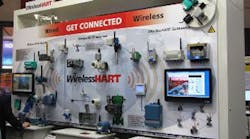With industrial Ethernet expected to double over a five-year period, the HART Communication Foundation has worked to provide Ethernet-speed capabilities over IP-based connections. At Hannover Messe 2014 this week in Germany, the foundation released its latest HART Communication Protocol, HART-IP. Supporting intelligent device management for smart process instrumentation, it simplifies system integration by eliminating manual data mapping, enables large-scale plant-wide wireless sensor applications, and allows tight integration of field instruments to enterprise asset management systems.
“An IMS Research study from February 2013 reports use of industrial Ethernet will almost double from 2011 to 2016,” said Ted Masters, the foundation’s president and CEO. “HART-IP addresses this growing industry demand for accessing data over the Ethernet.”
HART-IP connects to the plant networking infrastructure, enables enterprise-wide access to information, and provides fast access to measurement and device diagnostics. With their existing network infrastructure, users can now integrate intelligent device measurement and diagnostic information with their productivity, planning, historian or other applications.
“HART-IP offers the most straightforward way to access all the HART information available in a HART device,” Masters said. “It allows the information from HART devices to be brought up to the enterprise level easily, without the need to go through any translation processes and with no loss of information.”
The new protocol simplifies the system connection configuration, provides all available device data and eliminates mapping of registers, the foundation detailed. It reduces the system integration burden by providing remote and plant-wide Internet access to device analytics and process measurements using the plant network infrastructure. It ties together intelligent HART devices, multiplexers and WirelessHART gateways into a single plant-wide intelligent device management solution that works with any size plant and all HART-enabled devices.

